In 2010, 3D TV was certainly must-see technology. However, this is the year that 3D TV will move into the must-own category. More manufacturers are putting out 3D-capably HDTVs, and they are now even more affordable than they were last year.
Recently, research firm DisplaySearch came out with a report stating that 3D TVs accounted for about 10 percent of worldwide TV sales in the fourth quarter of 2010. They are also expecting that number to jump to 50 percent at some point, as it becomes a standard TV feature. If all goes well, about 100 million 3D TVs will ship by the end of 2014.
It's now officially a growing category, and there are more choices than ever. Besides price, size and manufacturer, you need to figure out whether you want to delve into active or passive 3D technology.
Get Active!
Last year, we gave you a bit of a 3D history lesson. Now, there's an entirely new tutorial to master. We need to dissect the differences between active and passive 3D TVs. At January 2011's Consumer Electronic Show, 3D was once again the buzzword. However, this time, we got to see the active 3D TVs and the passive 3D TVs.

Currently, only VIZIO, Toshiba and LG are producing passive 3D TVs. Those newer sets promise less flicker, brighter images, and a less expensive overall 3D experience vs. active 3D TVs. However, our own Chris Boylan gave us an overview of Passive vs. Active 3D TV, and highlighted the fact that passive 3D TVs don't pack the same punch when it comes to image detail. Current passive 3D TVs split the set's resolution between left and right eyes when in 3D mode, and this can produce artifacts that will annot those who are looking for the highest picture quality.
For the purposes of this Buyer's Guide, we will focus on active 3D, which has been the focus of 3D TV since it first launch into homes last year. This technology promises a full 1080p HD experience to each eye, using alternate frame sequencing technology and active 3D glasses.
Whaddya Need?
When it comes to active 3D TVs, you rarely get everything you need for 3D right in the TV box. Active 3D TVs require not only active 3D glasses, which are not included with the purchase price of many 3D TVs, but you'll also need a good 3D source, such as a 3D-capable set-top box or a Blu-ray 3D player. Some manufacturers are including one or two pairs of 3D glasses with the TV, but you'll still need to get a good 3D source. A few manufacturers are still trying to entice shoppers with 3D TV Bundles, which sometimes offer free 3D glasses, free Blu-ray 3D players and even free 3D Blu-ray movies, all with the purchase price of select 3D TVs.
Panasonic, Samsung, and Sony all offer some type of 3D Starter Kit, which typically includes two pairs of active 3D glasses and Blu-ray 3D titles that are exclusive to the respective manufacturer. At press time, Panasonic had a lock on Avatar through February 2012 and Sony was still offering a copy of Alice in Wonderland. Samsung knows how to entice, with the biggest package, which includes all four Shrek movies and a mail-in coupon for a free Blu-ray 3D Disc of Megamind.
It's important to note that, at this point, 3D glasses are still specific to the manufacturer. There are companies making universal 3D glasses. However, if you buy Sony glasses, they will only work with Sony 3D TVs, and so forth. So if you want to go over to your friend's house to watch his Samsung 3D TV, but you own a Panasonic, you won't be able to BYOG (Bring Your Own Glasses).
Of course, the growing library of Blu-ray 3D movies aren't much good without a Blu-ray 3D player. This component may be as important as 3D glasses at this point, since movie studios are starting to unleash more titles on the Blu-ray 3D format and these are unquestionably the highest quality 3D source for the home. But if you aren't quite ready to make that investment, know that there are other ways to get your 3D fix, via VUDU rentals, video-on-demand from cable and satellite providers, and even 3D-specific broadcast channels, such as DIRECTV's 3net.
And it's important to keep in mind: all 3D TVs also do 2D -- some of them quite well, in fact. For most of the time, these "3D TVs" can and will be used as standard HDTVs to watch your current library of movies and TV shows in high definition without any glasses. Many manufacturers, including LG, Samsung and Panasonic, also offer a real-time 2D-to-3D conversion feature, which adds a bit of 3D depth to everyday viewing of movies, video or still images. You'll still need glasses to see the 3D effect, and it's certainly not as awesome as watching a real copy of Avatar on Blu-ray 3D disc. However, it should give you a slight 3D fix until you have some of the other pieces in place.
So now you probably have one of those infamous 3D headaches. It's not from the glasses or the technology; all of this info is enough to make your head spin! If you want to find out a little more on the difference between active and passive technology, check out our "Passive 3D vs. Active 3D: The Format War of 2011?" For those of you ready to pick out a shiny new 3D TV, here is what manufacturers are currently offering in the active 3D category for 2011.
LG
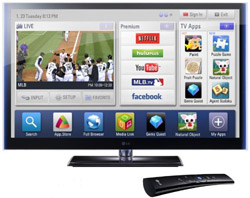
Of the four plasma series being offered this year, the PW350 series is on the lower end. Available in 42- and 50-inch sizes, this line offers LG's TruSlim frame, a 720p image (a 1024 x 768 if you want to get technical), 2D-to-3D conversion, the 600Hz refresh rate, and a 10,000,000:1 contrast ratio. Also, Intelligent Sensor tweaks the image based on the lighting and color conditions in the room, making for a better viewing experience.
The PZ550 series is the next step up, offering a full 1080p HD image on 50- and 60-inch models. Besides the TruSlim frame, the 2D-to-3D conversion, and the 600Hz refresh rate, these models also include DLNA support and NetCast. NetCast provides instant, on-screen access to services such as Netflix, CinemaNow, Yahoo widgets, Pandora and VUDU. Add in LG's AN-WF100 Wi-Fi USB Adapter, and you can tap into that entertainment via your home's Wi-Fi network.
The 50- and 60-inch models in the PZ750 series have all of the features from the PZ550 line, but throw in some very interesting extras. Each of the TVs have THX 3D certification, as well as a new web platform called Smart TV. Smart TV adds in extra web-based content over the NetCast service. Also, Smart TV has a whole new way of navigating through those options: the Magic Motion Remote. Similar to playing Nintendo's Wii, the Magic Motion Remote uses your motion to flip through services, videos, news, photos, and countless other content options.
LG rounds out its 2011 active 3D offerings with the PZ950 series. It may sound like a carbon copy of the PZ750's features list. However, this line's two models also have TruBlack Filter. This feature actually works to eliminate glare, while boasting a better picture quality with deeper blacks and enhanced contrast ratio.
Mitsubishi
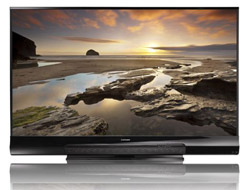
Just announced, Mitsubishi is planning on three different lines, all under its Diamond DLP Home Cinema TV Series. The 640 Series offers the "smallest" of the bunch, with just one 73-inch model. Instead of having to buy something extra, this model includes the necessary 3D emitter that can decode the "checkerboard" 3D format that the company incorporates into its active 3D TVs. Other features include a 120Hz sub-frame rate, an advanced calibration mode, and three HDMI inputs.
Next up is Mitsubishi's 740 Series 3D DLP Home Cinema TV Series, which has 73- and 82-inch screen sizes. Both feature a built-in 3D IR emitter and support for an iPhone/iPod Touch/iPad remote control app. The 740 HDTVs can be networked -- wirelessly, in fact, with an optional add-on adapter. Networking is a must to tap into StreamTV, which provides on-screen access to VUDU, Flickr, Facebook, Twitter, Pandora, and a slew of other apps.
The final 3D DLP Home Cinema HDTVs fall under the 840 Series, which has 73-, 82- and 92-inch models. Besides the 3D and StreamTV, all three models have a new Clear Contrast Screen feature, as well as Bluetooth Audio, a subwoofer output, ISFccc calibration support, and four HDMI inputs. One other cool, key feature is the immersive sound technology (IST) 16-speaker Dolby Digital 5.1 surround sound system, which is built right into the set.
Mitsubishi is also adding one LaserVue model, the 75-inch L75-A94. This big boy can access StreamTV via built-in Wi-Fi. Other features include the Clear Contrast Screen, Mitsubishi's proprietary laser light engine, Smooth 120 Hz Film Motion technology, ISFccc support, EdgeEnhance and DeepField Imager, a wired IR input, and four HDMI inputs. It also has the dubious honor of being the world's only laser-powered TV.
Panasonic
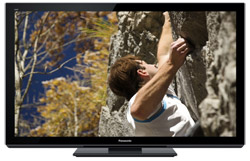
Full HD 3D Plasma HDTVs:
With a total of six screen sizes, the ST30 series has the Infinite Black 2 Panel, fast switching phosphors, the 600Hz Sub-field Drive, VIERA Image Viewer, DLNA support, VIERA Link, three HDMI connections and two USB ports.
New for 2011, all of these models include Skype support, as well as the VIERA Connect service. VIERA Connect is Panasonic's next-gen content service, with on-screen access to Netflix, Amazon VOD, YouTube, Pandora, Twitter, Napster, Hulu Plus, Facebook, and much more. Hook Panasonic's DY-WL10 Wireless LAN Adapter (included with all of Panasonic's 3D-ready full HD TV models this year) into an available USB port on the TV, and you can access all of those services through your home's wireless network.
The four models in the VIERA GT30 series have all of the same features that were mentioned above in the ST30 series, including VIERA Connect, Skype support and THX certification. Each of these models does add a few new connection options, with a total of four HDMI inputs and three USB ports on each as well as picture quality enhancements for enhanced black levels and contrast. These models also include automatic grey scale calibration with SpectraCal's CalMAN software.
At the top of the heap, Panasonic has two models in the VT30 series. What really sets these units apart from Panasonic's other 2011 offerings is that these have a one sheet glass design and an Infinite Black Pro 2 panel with a special glass treatment that further accentuates the panel's black level performance. The new panel promises more subtle, delicate blacks, in both dark and bright environments. Another nice bonus is that each model comes with one pair of active 3D glasses, for 3D viewing right out of the box.
3D Capable LED HDTVs:
Panasonic hasn't forgotten about you LED fans. For 2011, the company's DT30 LED/LCD Series offers two sizes for smaller rooms or for gamers. The DT30 series features full HD 3D resolution (1080p), a flush screen design, an IPS Alpha LED-lit LCD Panel for improved off-axis color saturation, the 240Hz refresh rate with Motion Picture Pro 4 processing, a Game Mode,and the VIERA Connect platform with Wi-Fi networking (includes LAN adapter). Other features inlcude the VIERA Image Viewer H.264 (Photo & Movie), DLNA certification, VIERA Link support, four HDMI inputs, three USB ports, a PC (DB15/VGA) Input, the ISF Pro Setting Menu and automatic gray scale calibration with SpectraCal's CalMAN software.
Samsung
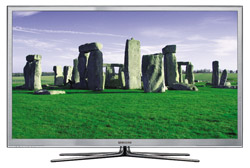
So what is that going to cost you? It depends on the type of TV you like. Samsung says that the LEDs in the D8000, D7000 and D6400 Series all have Samsung's proprietary 3D peak algorithm, which boasts brighter images and reduced power consumption. Even better, that technology automatically adjusts brightness levels in dark scenes to ensure bright images in every scene.
All three lines have a few common features. Samsung Smart TV includes Samsung Smart Hub, a new interface that allows viewers to search for video across connected devices and online content. It also provides access to all of Samsung's Apps, which has content from Netflix, Hulu, YouTube, ESPN, Pandora, and much more.
Another new perk is the new ONE Design ultra-thin bezel. This makes the size of all of the models in all three of the series much thinner, for a virtually edge-less TV viewing experience. Other new features include 3D Auto Contrast technology and 3D sound.
The D6400 Series features three of the manufacturer's most affordable 3D TVs. These 120Hz sets include Samsung's double-rate frame transition technology, which claims to reduce the picture frame transition time by 50 percent.
The two models in the LED D7000 Series come with the Quad Stand, which is slightly slimmer this year. Also, to make it an even more enjoyable experience, these TVs come packing a QWERTY keyboard remote, which makes it easy to surf through all of the online content these TVs can offer. Other features include improved backlight scanning technology and Auto Motion Plus, and Samsung's proprietary frame interpolation algorithm, which promises sharp 2D and 3D pictures and smooth frame transitions without blurring.
The two models in the LED D8000 Series have everything mentioned above, but boost the refresh rate up to 240Hz. Other features include the Ultra Clear Panel and Micro Dimming Plus technology, which promises rich, lifelike images.
If you're more of a plasma person, Samsung has you covered, with 13 different options. One major difference across this year's line is the Plasma+1 design, which introduces a narrower bezel to add up to one inch more of viewable screen size over last year's models in the same size chassis.
The two 3D TVs in the D490 Series offer 3D in an affordable package. Both deliver a 720p image, 600Hz subfield motion technology, ConnectShare Movie support, and two HDMI ports.
The D550 Series bumps things up to 1080p, adding in Samsung's trademark Touch of Color design. These three models also have AllShare support, which can be used wirelessly via Samsung's optional WIS09ABGN LinkStick Wireless LAN Adapter.
Things get a little more interesting with the D6500 Plasma Series. These two models have Smart Hub features and built-in Wi-Fi.
The D7000 Plasma Series has the same features mentioned above, but adds in Samsung's signature brushed metal bezel design and a proprietary Real Black Panel to cut the glare and boost the on-screen image's contrast ratio.
As the final three Samsung plasmas, the D8000 Plasma Series also includes the Samsung's Quad Stand. Other unique features include the Local Contrast Enhancer (LCE) and Cinema Black, which promise to boost black performance even further than on the D7000 series.
Sharp
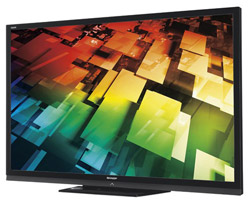
Coming this July is the LC-70LE735U, a 70-inch AQUOS Quattron 3D LED HDTV. Besides the 3D features, this HDTV has the Quattron Quad Pixel Technology, a full 1080p HD image, and built-in Wi-Fi to connect to online services.
Sony
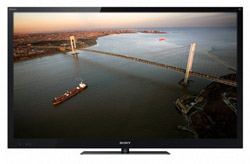
Another feature on all 16 new models is the BRAVIA Internet Video platform, which includes Sony's Video On Demand and Music Unlimited powered by Qriocity service, as well as Netflix, Pandora, HuluPlus, Amazon Video on Demand, YouTube, and more.
The least expensive way to get your 3D fix from Sony is in the EX720 Series. Offering 1080p images and Edge LED backlight, these five models have MotionFlow XR 240, the X-Reality Engine video processor, and Skype support. If you want to network these TVs wirelessly, you'll need to buy the optional USB Wi-Fi Adapter.
Next up is the HX729 Series, which has a total of three screen sizes with a 1080p image and Dynamic Edge LED backlight. A few other highlights include MotionFlow XR 480, the X-Reality PRO Engine video processor, Skype support, and built-in Wi-Fi. All three also offer two-way IR inputs and two-way RS232C control.
The three models under the NX720 Series also have the 1080p image with Dynamic Edge LED backlight, the built-in Wi-Fi, and the Skype support. The difference here is that these drop the PRO part from the X-Reality Engine, as well as the MotionFlow to XR 240. Also, these HDTVs have a new Monolithic Design, which integrates OptiContrast Panel Technology.
The two models in the HX820 Series are almost idential to the HX729s. The one major difference is that these include the Monolithic Design with OptiContrast Panel Technology.
Three screen sizes comprise the top-of-the-line XBR-HX929 Series, which includes a 1080p image, Sony's Intelligent Peak LED backlight, and an improved Monolithic Design. Another new feature is MotionFlow XR 960, which has backlight control that is synchronized with the liquid crystal movement from frame to frame, for better, sharper images.
Other features include the X-Reality PRO Engine video processor, built-in Wi-Fi, Skype support, a rear IR-input and a two-way RS232c connection.
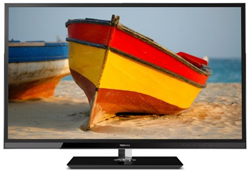
Toshiba has one active 3D line for 2011. However, the UL610 Cinema Series does come in three different sizes. All three models feature the company's full HD 1080p Quantum Black LED Panel with Fine Local Dimming and CrystalCoat, which boasts deep blacks and dramatic contrast. Other features include CEVO-powered 480Hz ClearScan technology, built-in Wi-Fi, Net TV with Yahoo Widgets, and a built-in subwoofer speaker.
Also Check Out These Related Articles: